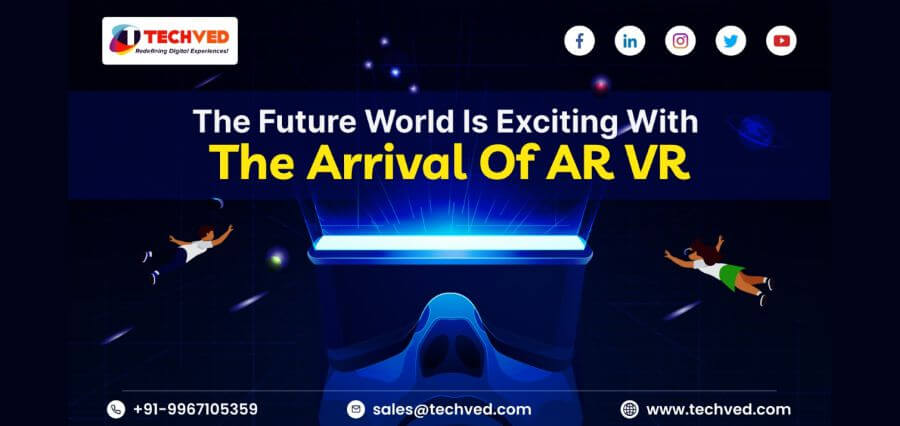What is made feasible when technology becomes less prominent? We get to experience life from above. Every day we get to defy distance. Even if they are thousands of miles away, we may be more present with the people who matter to us. These fantastical possibilities are ready to be delivered via Augmented reality (AR) and Virtual reality (VR), elevating connectivity to new levels.
In these times of rapid technological advancement, augmented reality and virtual reality are both expected to become increasingly significant considerations in a wide variety of different ways. With AR glasses, being able to overlay visual overlays on your real-world view, and VR headsets provide a whole new level of immersive connection with the world around you.
As with previous technology shifts, such as mobile connectivity, both elements are also evolving in the same way, and it is only a matter of time before both elements become more widespread and valuable within everyday life, as well as influencers of everyday trends.
People’s interest in AR/VR is growing around the world.
There is no doubt that 75% of all business owners are planning to use augmented reality or virtual reality in the next two years, and that global spending on AR/VR will increase by 6x in the next two years.
Some months back, Facebook launched a full report about the future of AR and VR.
Data shows that English-language searches related to AR and VR on Facebook have grown nearly twice as faster in emerging markets than in mature markets. Another indication that the potential for AR and VR in emerging markets has not yet been fully realized.
There is no doubt that interest in using more immersive technology platforms is going to be key to future growth, as can be seen from the trend data here, indicating that more immersive tech platforms could be the key to connecting with consumers in whole new ways…
By providing experiences from a “eyes-up” perspective, AR and VR can make the impossibly conceivable. Wherever we may be in the physical world, we will be able to truly put ourselves in another person’s shoes, explore new interests, promote equity, and interact with businesses. We can discover what’s happening in each of these fields right now and how AR and VR might develop in the future:
Promoting commerce
The path to purchase as we currently know it will disintegrate as AR and VR enhance the online purchasing experience. Brands are already using augmented reality to let customers overlay things on themselves and their surroundings without going to actual stores. However, there will be more opportunities in the future for consumers to engage with brands, including one-on-one meetings with designers they admire and factory tours. See how linking the digital and physical worlds with augmented reality might change the way people purchase things.
Pursuing passions
Our activities are now constrained by things like cost, distance, time, and access. In the future, AR and VR will make a wide range of options available and cheap for everyone.
Redefining productivity
The world will become more efficient and equal as AR and VR transform everything from school classrooms to hospital operating rooms. Imagine a world where surgeons can learn difficult techniques without endangering patients’ lives, or where multinational corporations can train employees consistently and immersive across national borders to save time. We can discover how working from anywhere at any time will be made possible with VR.
Fostering empathy
VR has a strong capacity to aid in our understanding of others’ experiences. That is exactly what the American film We Live Here does. In order to elicit empathy and take action, this VR short immerses viewers in the life of a person who is experiencing homelessness.
There was a nice example presented during the launch of Facebook’s latest report on AR/VR, which demonstrated the potential of AR to drive business success in a innovative ways. With the help of the QR code below, users were able to open the Facebook app, dive into a shark cage in South Africa, and book an adventure with a fictional business, all in a single moment, as a result of scanning the QR code with their smart phone camera.
From the future perspective,
How AR/VR will be the new dimensions of connection.
The potential to create communities and unite the world will be more of an emphasis for AR and VR technology. Since they acknowledge the significance of developing these technologies ethically, AR and VR could be some of the most effective accelerators for attaining these objectives.
We are all responsible for shaping the future. We’ll need to work together across national boundaries, philosophical differences, and ideological divides to construct it, from people and small enterprises to major organizations and global corporations. In fact, the scope of collaboration may exceed anything we’ve ever witnessed. Although many of the technologies we’ve mentioned might not be yet available, we need to consider how to set the stage for success of those technologies in the future.
Our lives will take on a new dimension of presence thanks to AR and VR, allowing us to interact with others in immersive, real-world settings regardless of distance. And there are already indications that there is a need for and a desire for these new technologies.
Conclusion
AR and VR are poised to deliver magical possibilities, allowing us to connect in immersive and authentic ways and break down physical, mental and societal boundaries. We’re seeing signs of a need for these new technologies, and soon they will become ubiquitous.
AR/VR can enable experiences that were previously impossible in many ways, as delivering experiences that inspire commerce, redefine productivity, pursue passions, and ignite empathy. We are already seeing brands incorporate AR in online shopping, and people being transported to cultural institutions around the world. The future holds even more ways for people to connect with brands and explore different opportunities.
Written by
Jay Anthony,
Marketing Head, TECHVED Consulting


